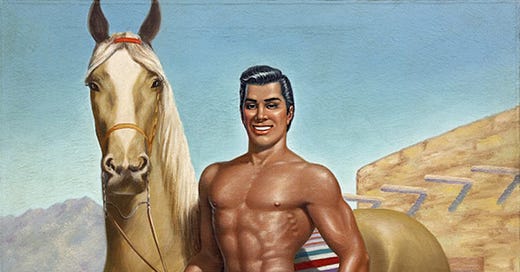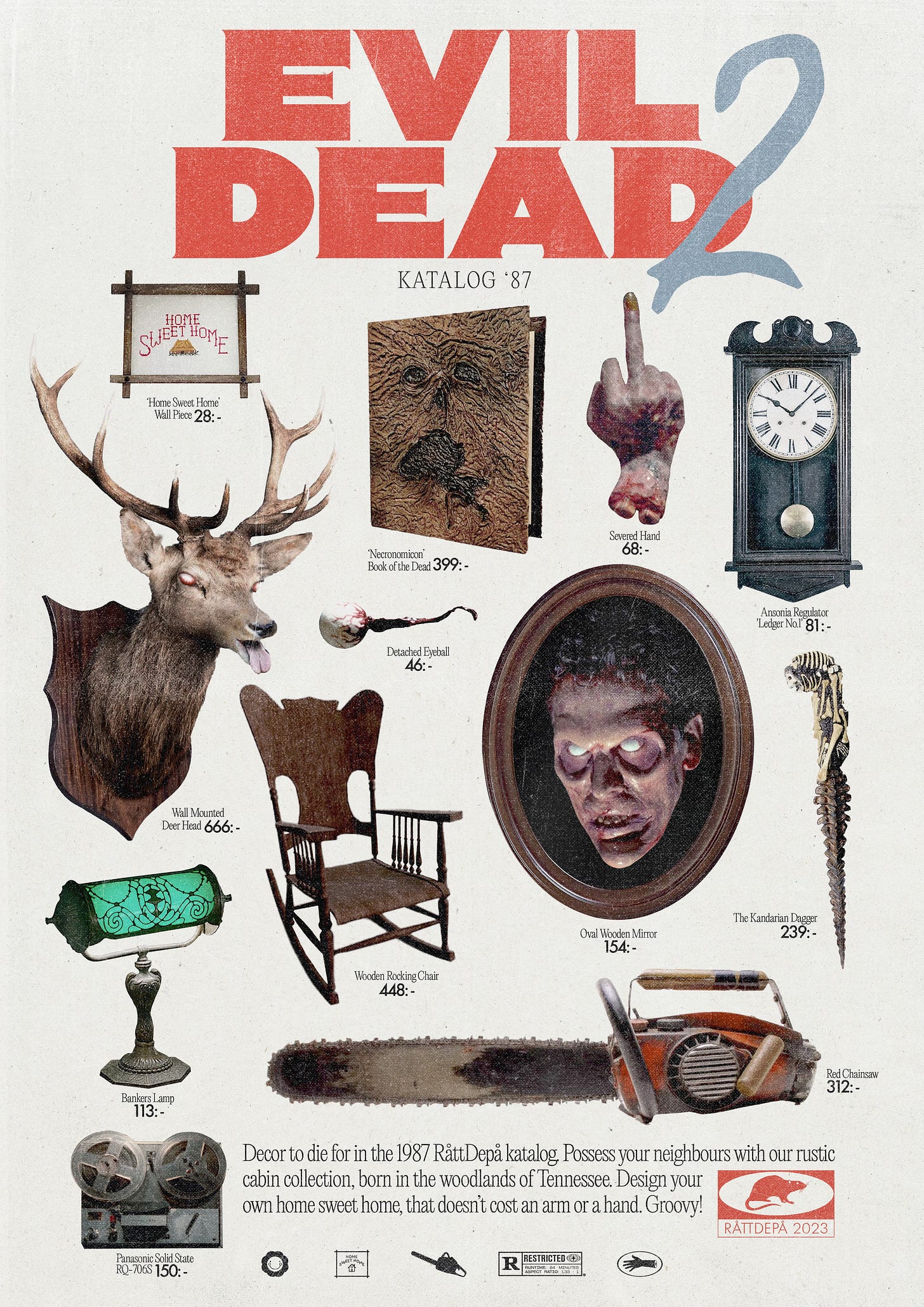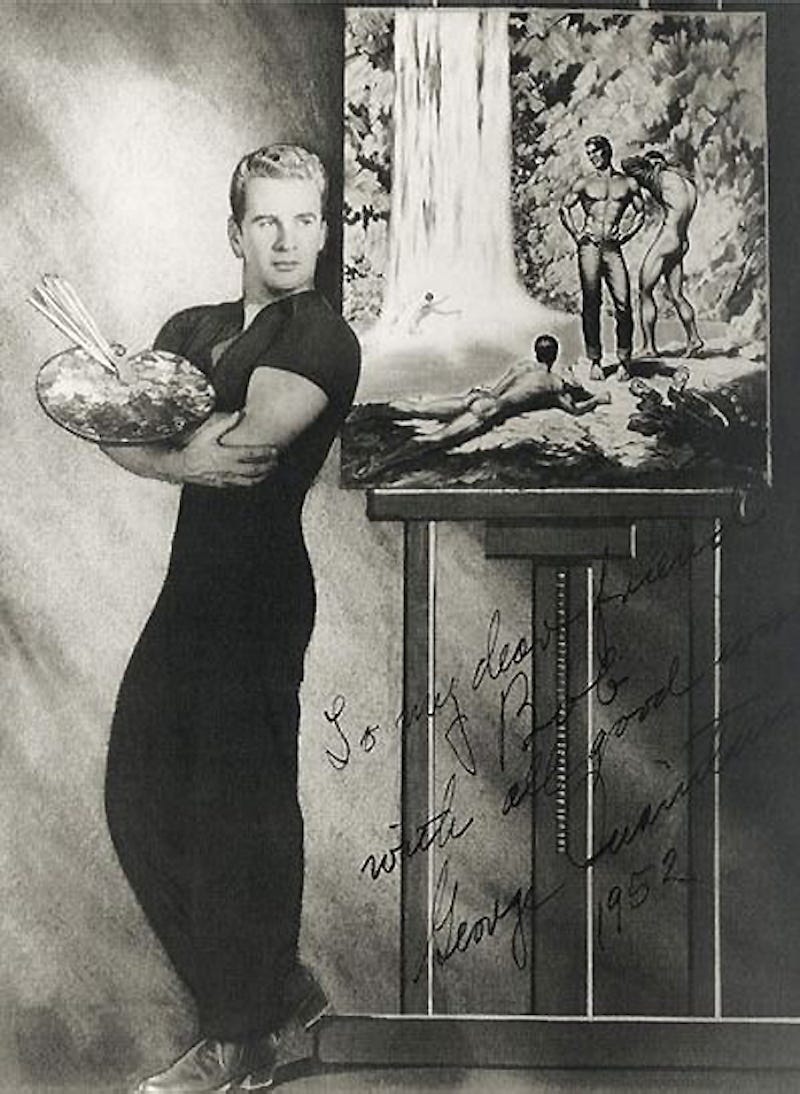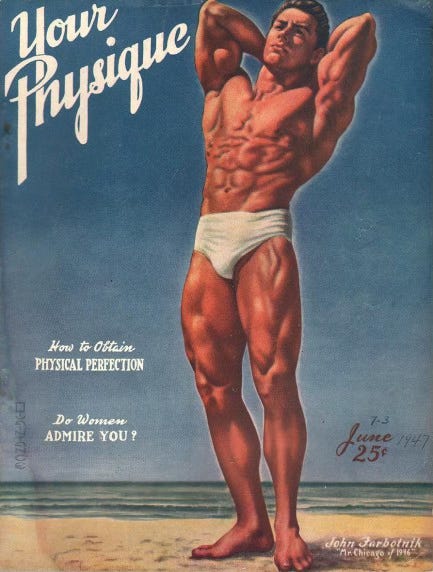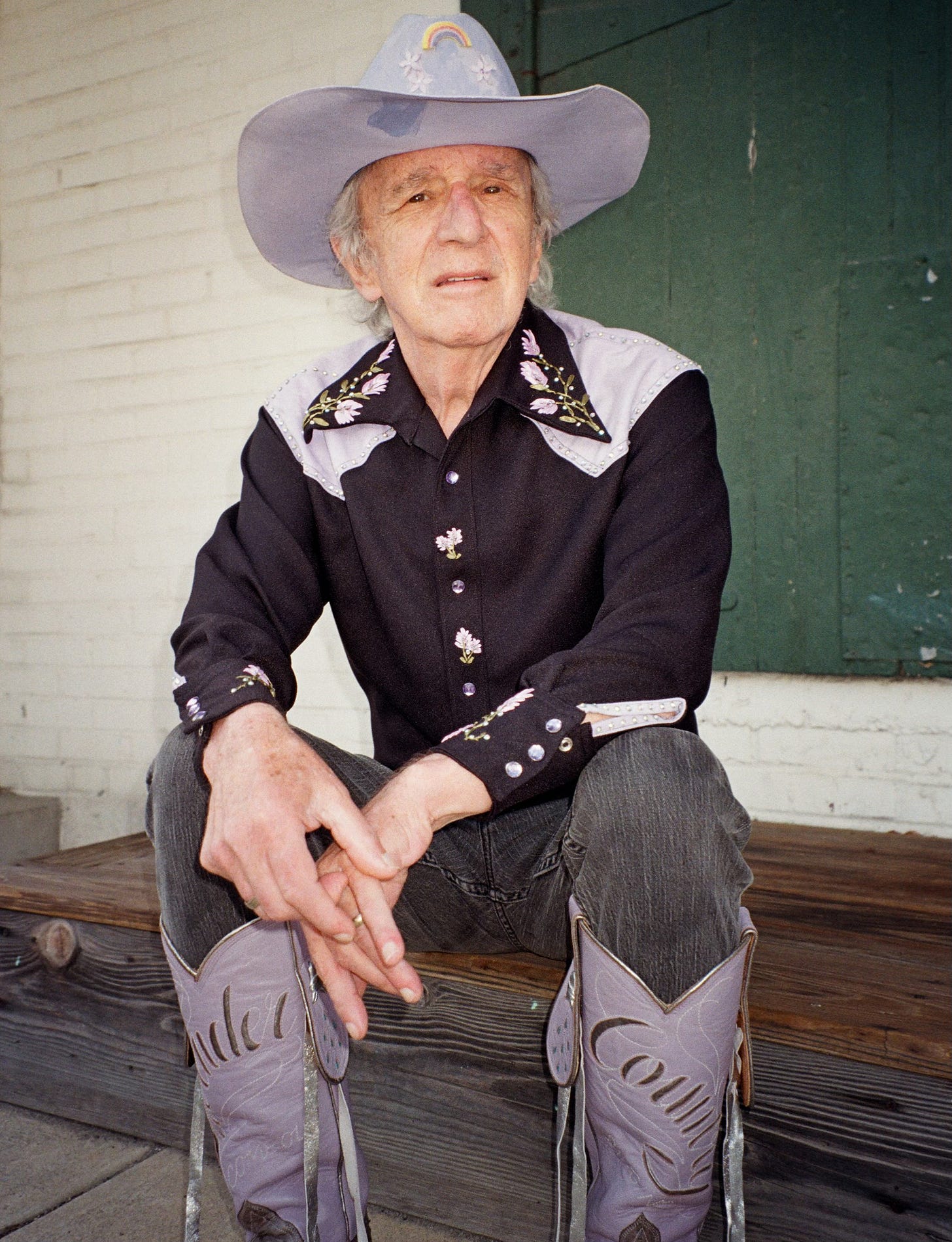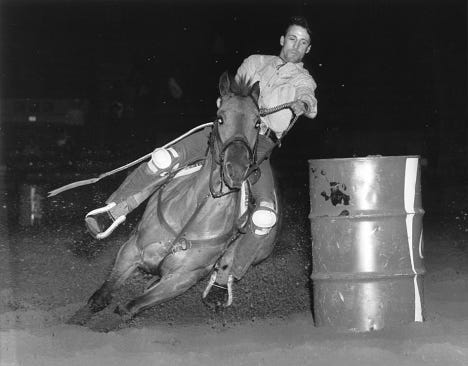Howdy partners! How’ve you been this week? Mia has been going rat mode the past few weeks designing all the sexy print materials for our next screening and the wait is OVER! Here is Mia’s Evil Dead 2 poster, inspired by IKEA catalogues of old.
I’m assuming you’re all sat at home clapping right now because you should be! Mia works full time as a graphic designer and has dedicated her nights to producing an amazing set of graphics for this event. Pleaaaase show her some love by giving the post a like and keep an eye out, as the poster will be available to order online as well as on the night soon. But for now, let’s talk about sexy cow people.
George Quaintance (1902-1957)
What’s your favourite brand of cowboy? A little Mitski number? An Orville Peck for you? A pre-TB Arthur Morgan as a treat? One thing we can agree on, is that they can be very sexy indeed. Perhaps no other artist in the twentieth century understood this more than American artist George Quaintance.
Born in 1902, Quaintance grew up on a farm in rural Virginia as a closeted gay man. At 18, Quaintance would study at the Art Students League in New York City. Over the years though, the artist would wear many different hats before settling on the Stetson; as a hairdresser, photographer of the rich and famous and as a stage director for productions in his hometown.
It was in the twilight of his life that Quaintance’s art really took off. The Virginian had always had an affinity for the Wild West but struggled to fully connect with the - seemingly - heteronormative machismo inherent in the cowboy lifestyle. That was, until he unlocked the deeply homoerotic potential of a bunch of buff dudes doing buff shit in the desert unattended.
By the 1950s, Quaintance was booked and busy with commissions, largely down to his shrewd business acumen and the ability to market his work effectively to an anonymous and nebulous target audience. Placing ads in popular male physique magazines across the US and Europe, Quaintance advertised his catalogues of nude model photo sets and paintings to a private mailing list of - reportedly - tens of thousands of people. Quaintance also produced cover art for male physique magazines such as Your Physique (below) which only served to embed him in the community of those uh, invested, in the male form.
Ultimately, it was a weak heart and the endless travelling between states on business that cut Quaintance’s career short, with the artist moving from Arizona to California in 1956 after a heart attack, in part to access better medical facilities. In those final years of his career, Quaintance’s art seemed to shift focus and form. The cowboy aesthetic that had been so popular for years lost its appeal and George began working on smaller canvases, perhaps out of fear he wouldn’t finish as many in time. Quaintance began painting characters from mythology, in particular gods such as Zeus, the all powerful sex pest and Bacchus the god of wine and debauched vibes… all the horny ones in other words. This late-career shift revealed a fascination for a different type of erotic appeal - not the hard, sweaty, youthful graft of the cow herder but the innate perfection of an immortal god, the perfect counterweight to George’s own fraying physique.
What George Quaintance would not live to see was the influence his work would have, not only on gay erotica in the United States but on the very concept of the cowboy. While it’s common to associate cowboys with gay life now, thanks to films such as Brokeback Mountain and The Power of the Dog, or artists like Lavender Country, Orville Peck and Lil Nas X, Quaintance was a singular artist during an era of intense moral scrutiny and conservative views, popularising a pulp fiction trash-lit book cover style of homoerotica that gay people across the world could enjoy.
Lavender Country (1944-2022)
There's nothing left but holes
In your weary sexist roles
Time to trade them old P.J.'s
For a Goodwill negligee
You all come out, come out, my dears
To Lavender Country
In 1973, country band Lavender Country released their eponymous debut album, to the tune of just 1000 copies, distributed by mail order and sold in any bookstores and music stores that would stock it. As the first openly gay country band in the United States, the debut album was proud, flamboyant, tongue in cheek and radical. Far ahead of its time, Lavender Country would disband a few years later and the album would fade into obscurity. That is, until it was re-released by North Carolina label Paradise of Bachelors in 2014, sparking a new generation of listeners to appreciate the amateurish, joyful country music that founding member Patrick Haggerty and co had put into the world.
The angriest and most politically charged track on the album is Waltzing Will Trilogy, a song about the evils of conversion therapy. Haggerty himself had been sent to a mental hospital to ‘cure’ him in 1966, after being dropped from the Peace Corps due to his sexuality. Haggerty’s radical ideals permeate the call to action as the song ends, imploring for a “good dose of insurrection” to “wipe that claptrap jailhouse off the map”. By contrast, To A Woman is a soft, simple lesbian love song from original band fiddle player and singer Eve Morris, who also provides vocals for Cryin’ These Cocksucking Tears, one of the most popular songs from the album.
This video features an interview with Haggerty that contextualises the album and reflects on its newfound popularity, as both a cultural artefact and something contemporary listeners can still enjoy. By 2021, Haggerty had opened for Orville Peck and duetted with Trixie Mattel on their cover of I Can’t Shake The Stranger Out Of You, touring again after decades of obscurity, bolstered by the love shown to him by a worldwide audience. Speaking to Billboard that year, Haggerty exclaimed that “we’re all over. Many of them, especially the transgender artists, are very radical and anti-capitalist and political. For years I was by myself; now I have an entourage of country performers who think I’m their grandpappy or something”.
Patrick Haggerty did not have an easy life. Discriminated against in the Peace Corps and then routinely throughout his career, diagnosed as mentally ill for his sexuality, forced to mourn friends lost to brutality and hate. For many years, Haggerty was unable to get jobs or book gigs, living off food stamps or seasonal work, staying in communes. Despite everything that the world spat at him, Haggerty remained true to himself and created a defiant, optimistic sound that formed the blueprint for some of the most popular artists in the world today. In his final years, Patrick saw glimpses of the world he had envisioned half a century ago. And he must have finally known how people would remember him - that same old “screaming Marxist bitch”, an icon of country music.
Gene Mikulenka
The horses don’t care if you’re straight or gay, they’re still going to buck you
Texan cowboy and rodeo Gene Mikulenka is not someone you’re likely to know. He’s not particularly famous or well known, or renown for his prowess in a specific field. As the subject of Kyle Henry’s 1998 documentary American Cowboy however, he offers insights into life as a gay rodeo cowboy in a deeply conservative, Republican state. Mikulenka is a man who loves his horses and lives and dies by rodeo. Early in the documentary, we see Gene break his leg and go through rehabilitation to get back on his horse.
During this period, he reflects on a horse he owned that died from colic, a leading cause of death for the animal. His emotion towards the horse, alongside his disregard for his injury as he tries to get back into the saddle, paints a picture of a kind, empathetic man who knows no other way of life. For most cowboys, this lifelong devotion to the lifestyle is what preserves and celebrates their culture.
The rodeo circuit in Texas is run by cowboys, for cowboys and the gay scene is no different. As Gene meets up with fellow rodeos at a tournament in Albuquerque, he speaks with veterans of the circuit about retiring, about it being his last ride. There’s a sense of one version of Gene dying and another being born, as he plans his proposal to his boyfriend. As a semi-closeted man during filming, Gene’s approach to the documentary is simultaneously vulnerable and guarded but also open and optimistic about the future. Treating it as a “coming out” tape, Gene reflects on how he wants it to go, suggesting shots to the director - such as him sat in a bubble bath with his leg cast sticking out - and letting him know what he does and does not want to reveal about himself.
The clip above is wonderful. Gene psyches himself up for what he believes will be his last rodeo, flexing his legs in a rhythmic pattern, mimicking the leg movements you make riding a horse. A parade takes place in the arena; cowboy trucks, flags, sashes and big ol hats march through the venue. The tension in Gene’s body, on his face, clashes with the joyous, colourful parade parties. And when it’s time to rodeo, Gene does so to a small crowd of loving cowboys. The stands are not packed, the press is not there. It is after all, a closed event, operating mostly through word of mouth. When Gene performs he does so for his community. The crowd, who will also perform themselves, take it in turns to cheer each other on. The love from that small group is palpable, loud enough for Gene to hear it through the blood pumping past his ears.
Gene wins the top prize at the tournament, hopping up on crutches to collect it. The camera cuts to Gene holding a breast collar and headstall (or crown), equipment that his old horse Marta had won before it passed away. He chooses to gift this to his fiancé, Steven. Speechless, Steven is moved to tears. The pair share a moment, not needing to say much at all. They rise together, and walk away into the credits.
That’s all for this week, bababing and/or badaboom! Hope you enjoyed? Remember to show Mia some love on the ol insta, and if you live in Leeds or know someone who does, get a ticket to our next screening!
I’ll see you again soon, be well.
Love,
Paulie xx


